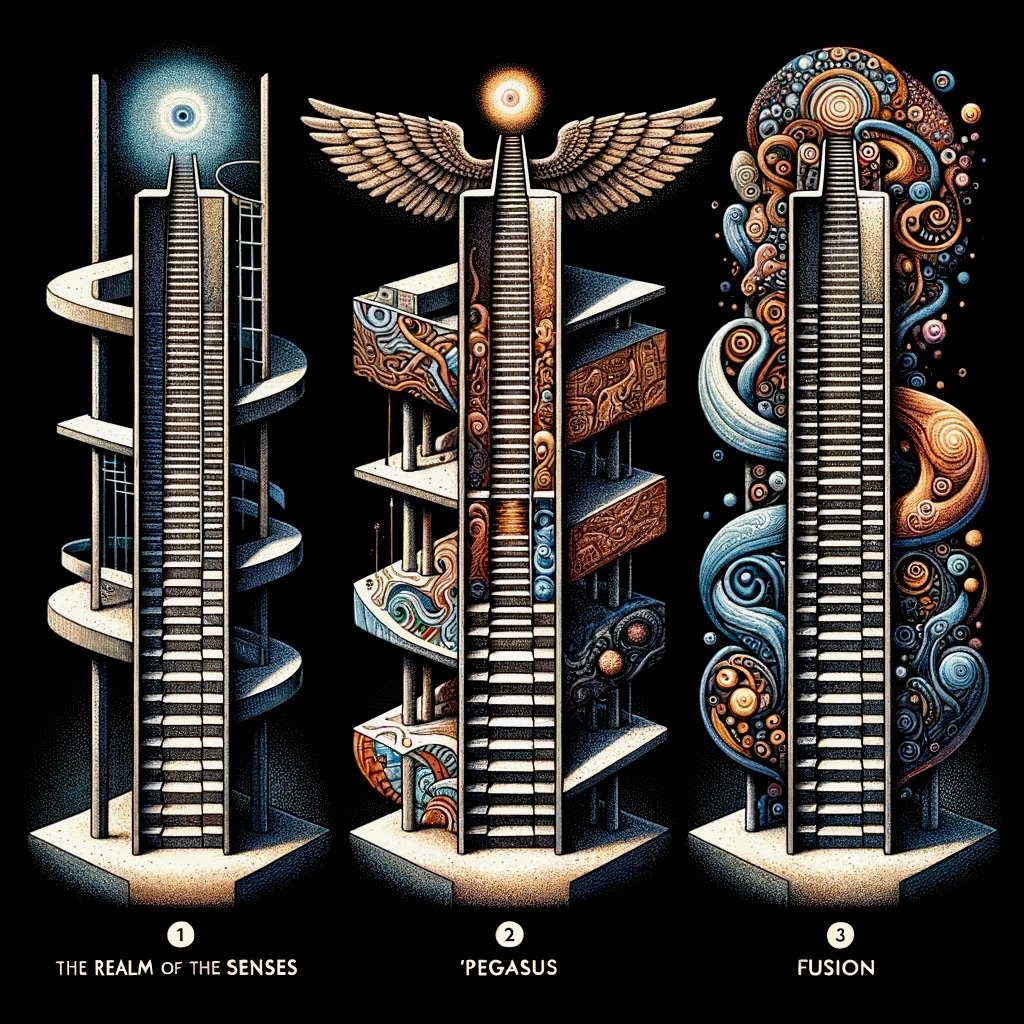Imagination as a Muscle - Part 2
Learning to climb the ladders of Imagination
The Imagination Gym- How to Build Your Imagination Muscle.
In my previous post, I explained how exercising your imagination muscle can help you strengthen and improve your ability to imagine. Although it may seem uncomfortable initially, it becomes easier and more natural with time. The size and shape of your imaginative muscle, which you first discover as a child, is unique.
When you build your imagination muscle consciously, you'll realise that the world around you is the biggest Imagination Gym. If you're in India, you can access a well-equipped one with all its diversity, and it's free! All you need to join this gym is to have an open mind and be curious about everything around you.
What practices can you incorporate as a part of your routine to significantly enhance your imaginative well-being- which is as important as your physical and spiritual well-being?
These practices are mindfully observing the world, embracing risk, practising interdisciplinary thinking, and having meaningful conversations by creating conducive learning environments. Connecting with nature and travelling off the beaten path is a great way to strengthen this 'muscle'.
Anavila Misra's success in building the 'Anavila' brand of sarees is an excellent example of applying these practices to make one's imagination muscle.
She reimagined the traditional sari, turning linen, a fabric not typically used for saris, into a popular choice among today's fashion-conscious women. This sari significantly changed from the usual, heavily embroidered cotton and silk saris, showing how imagination can transform fashion.
A Six Yard Garment
Anavila graduated from the National Institute of Fashion Technology (NIFT), India and began working in the Indian handloom industry.
She said,
I began working on a cluster development project with the Ministries of Rural Development and Textiles. The exposure to the textile belts of India and the skill set of our weavers pulled me; I always admired the texture, feel and luxury that comes with the comfort of linen. So, linen was an obvious choice when crafting my work's language. Creating something new and contemporary in the sari sector and bringing comfort led me to work with linen in saris.
Her 'Vann' saree is about simplicity and embracing Bundi’s forests with their natural colours and patterns. Anavila took a chance with linen, which worked—her sarees are now both stylish and practical. She uses her broad knowledge, from art to nature, to create unique sarees inspired by the environment and traditional craft techniques.
Teten's Three Ladders of Imagination

How do we define imagination?
Where do we find a theory that makes sense to us today?
When we feel blocked by a wall or stuck in a hole, will these ladders help us climb up and out?
Is there a device that will catapult us so that we can soar higher and further than what we would have ordinarily- like Anavila Misra and so many like her?
Teten's three ladders address these questions.
As we move up the rungs of each ladder, we become more deeply engaged with creativity and innovation.
Johann Nicolaus Tetens, born in 1736, was a German philosopher and the son of an innkeeper. He led an unimaginative life. He taught physics, philosophy, and psychology until he was fifty, and then, in a career twist, he spent the rest of his life working on life insurance and calculating widows' pensions in Copenhagen.
Fortunately, he also developed a theory of imagination, whose relative simplicity and intuitive clarity still make it appealing.
The First Ladder- The Realm of the Senses
This ladder is a base level of imagining that Teten calls 'Perception-svermogen' or 'the ability to perceive'.
Albert Read says, 'We start imagining as we breathe – lightly and unknowingly'.
We form a picture of our reality through our senses- what we see, feel, and hear. We perform simple, imaginative tasks like conjuring up the image of a horse because we have seen many horses before.
Similarly, in our professional lives, we rely on our past experiences to identify quick fixes or solutions for a customer's problem.
For instance, Sam, my coaching client, leads a team of over 2000 people, most of them fresh graduates or MBAs selling financial products.
However, the high attrition rate impacted customer delivery, and Sam was concerned that he may have to let go of the business. When I asked him what he was doing to fix the problem, he explained his approach - interviews, analysis, identifying gaps, and performance incentives.
But when I asked him if it was working, he replied negatively, saying he felt helpless and was unsure about himself.
I asked him to redefine the problem.
Although it was a complex issue with multiple variables, Sam had defined it as a problem of attrition. However, I encouraged him to look beyond the cliche and realise that the problem was disengagement, and attrition was only one of the outcomes. People could be disengaged, stay back, and underperform.
Sam returned with renewed enthusiasm and began to imagine how he could address the challenge of disengagement, marking the start of his climb to the second rung. We scheduled a follow-up meeting in two weeks.
The Second Ladder - Pegasus
This time, the imagination breathes deeply and wilfully, filling the mind with the oxygen of observation.
Teten uses the analogy of Pegasus to illustrate the second level of imagination: the next ladder. It involves the act of creating surprising connections between ideas. A person with an active and conscious imagination can conjure up an image of a flying horse without ever seeing one.
Entrepreneurs who climb the second rung of imagination create tremendous value for themselves and their customers. They develop ideas transforming industries and economies, just like Steve Jobs and Steve Wozniak did when they founded Apple Computer in 1976. The Apple I and Apple II revolutionised personal computing and made work more efficient.
Similarly, Elon Musk and Peter Thiel cofounded PayPal, which specialises in internet money transfers and enabled businesses like eBay to grow exponentially.
We are all born with an imagination muscle that needs exercise. We need the awareness and confidence to climb the next ladder, just like Anavila Misra did. If we can do that, it can be liberating.
Sarang Sathaye, Anusha Nandakumar, and Paula McGlynn chose to exercise their imagination muscle when they came together to create Bhadipa. It's a Marathi YouTube channel/ production house with over a million subscribers that has something for everyone. Marathi humour in the form of plays and short stories has a long and rich tradition, but Bhadipa is the first Marathi digital channel that has transformed its reach.
Sam exercised his imagination to reimagine the role and found that younger people want to learn in a fun and engaging way while respecting their boundaries, such as not working on weekends.
Sam devised a unique idea to establish a connection with the recently employed workers by splitting the day into two halves, morning and evening, and introducing different activities for fun and learning for each half. He also encouraged his team to welcome feedback from the newly hired employees. Moreover, Sam coached his direct reports on how to engage with young people.
The first quarter figures have come down, and engagement levels have increased.
On the second ladder, it is here that for most of us, the imaginative fruits lie.
The Third Ladder- Fusion
Fusion fuels the third ladder, where brilliant and wilful individuals, scientists, inventors, and artists create something new by fusing elements.
Transformational leaders operate at the pinnacle of imaginative practice, connecting and transforming for a far-reaching impact.
Steve Jobs bet on the iPhone, transforming our work and social life. Elon Musk reimagined the EV industry and space travel.
The India Stack revolutionised how we pay, buy, and transfer money. Large language models such as Open AI and Anthropic's cofounders Daniela Amodei and Dario Amodei have let the AI genie out of the bottle.
We all have Aladdin's AI lamp with limitless wishes. We need to learn how to use it.·
Imagination as an Antidote to Failure
As an executive coach, I always ask someone when I begin coaching them,
Tell me why you do what you do ?
And the answers are always revealing.
Dr Gio Valiante, a leading performance psychologist, asked over 1000 executives, top-performing athletes, and golf pros this question. Based on his research, he found that the answers usually fall into two categories- mastery or an ego orientation.
These are two different mindsets.
If you are curious, love learning and solving problems and are intrinsically motivated, you have a mastery orientation. You will likely perform well under pressure because the doing other than the outcomes incentivise you.
If outcomes drive you- a promotion, a large bonus, a career-changing assignment; you have an ego orientation. You may avoid pressure situations where the risk of failure is high because you want to avoid the embarrassment of being seen as a failure.
As a golfer, I have experienced this first-hand. When I play a poor shot(it happens pretty often), I laugh at myself and do not look around anxiously, wondering if my buddies think poorly of me. I usually recover and play a good game.
According to Dr Gio Valiante, who coaches the top PGA golf professionals,
The number one agreement I have with anyone who ever wants to work with me is telling them you have to promise me that you're going to take the embarrassment out of the equation because I can't make you great if you're willing to react with embarrassment.
It's essential to have both mindsets, but the mastery mindset should come first, followed by the ego orientation, which allows us to respond more effectively to setbacks.
Those with a mastery mindset rely extensively on their imagination- it's an antidote to any setback.
How do we lead fulfilling lives and be unperturbed when we face setbacks and failures?
Step 1: Build your imagination muscle in the largest Imagination gym - the world around you.
Step 2: Believe in yourself and climb Teten's second ladder- Pegasus. This is where you can make a difference to yourself and the world.
Step 3: Start with a mastery mindset- your imagination will help you achieve your potential.




